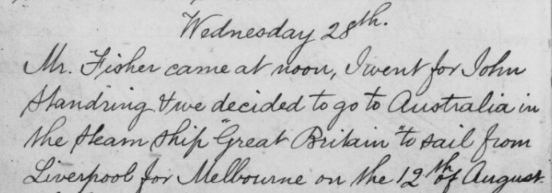
Pinpointing the date and place of arrival of your ancestors can be an evocative moment, as you cast your mind back and imagine their journey and ongoing lives. There are a range of records you can use to research your ancestor’s journey – but unfortunately not all passenger lists have survived.
The Public Records Office Victoria is the repository for all Victorian passenger lists up until 1923. On their website, you can search and view the following digitised passenger lists.
- Unassisted passengers lists 1852-1923
- Assisted passenger lists 1839- 1872
- Coastal passenger lists 1852 -1923
- Outwards passenger lists 1852 – 1923
From 1924 onward, immigration records are held by the National Archives of Australia.
For more information on the sorts of records you can use to research your ancestor’s journey, please see our Victorian immigration and emigration and Ships and shipping research guides. These guides identify the sorts of records you can use for Victorian arrivals over different time periods and from different repositories.
Elusive ancestors
As mentioned above, not all records have survived, but you can use other resources to try and narrow the time when a person or family might have arrived. Post office directories, and after 1903, Commonwealth electoral rolls can be consulted – many available online through the Ancestry database (available for free in the Library building).
Trove’s newspapers and gazettes search can pick up an advertisement for a business or reportage on your ancestors activities.
Departure records can be another avenue to explore, but their availability is also limited – for example – departures from UK ports are only available from 1890-1960. If you would like to search these they can be viewed on the Ancestry and Findmypast databases (available for free in the Library building).
Sometimes a child or minor traveling with an adult is not recorded by name, and so unfindable in an index, but is listed as ‘child with’ in the original record. Try searching for parents names in the digitised passenger records, then browse through them.
Ancestors may have arrived in another part of Australia initially, and then traveled across overland or by ship to Victoria. If you think they may have arrived in another state first, try searching that state’s passenger lists. There are also some records available for coastal voyages (travelling from another part of Australia into Victoria). Unfortunately, there are no records of overland arrivals.
A Victorian death certificate usually lists how long a person lived in the colony/state (e.g 10 years Victoria). This can be used to estimate the approximate year they arrived in Australia. However, please be mindful that this information is recorded by an informant (usually the next of kin) and may not be accurate.
You can try looking for newspaper obituaries for an individual – they sometimes mention the year the person came to Australia and ship they came out on. Try searching Trove’s digitised newspaper website for the name of your ancestor.
If you already know the name of a ship, it pays to browse through the whole manifest, to see if you can spot a name.
Shipboard diaries
To get a flavour of the experience your ancestors underwent on their great voyage you can try looking for a diary or journal from your ancestor’s voyage. Even if your ancestor did not keep a journal – someone else may have from the same voyage, or on the same ship in a different year. Some are available through the Australian Joint Copying Project, Miscellaneous series. For example, if your ancestor travelled on the record breaking Great Britain, sailing from Liverpool, you could look at Daniel Higson’s diary:

To find other shipboard diaries, consult the book ‘Log of logs : a catalogue of logs, journals, shipboard diaries, letters, and all forms of voyage narratives, 1788 to 1988, for Australia and New Zealand and surrounding ocean’ which is available to view in our Newspapers & Family History Reading Room.
Guides from other libraries and archives
- Immigration and shipping (State Library NSW).
- Immigration to South Australia .
- Shipping and immigration records online (State Library of Queensland).
- Shipping and passengers – (National Library).
- Research guides – (National Archives of Australia – immigration – for British, Chinese, Jewish, child and child migrants).
- Australian National Maritime Museum – links to research guides.
Further reading
- Migration to new worlds – official and personal documents charting the migration experience over 200 years. Database available from home with State Library membership.
- Thiele, Francis, 2001, Recreating the Polite World – Shipboard Life of Nineteenth-Century Lady Travellers to Australia, La Trobe journal, No 68, Spring, pp 51-62.
- Hassam, A, (ed.), 1995, No privacy for writing: shipboard diaries 1852-1879, Carlton, Melbourne Univesity Press.
- Charlwood, D, 2015, The long farewell : the perilous voyages of settlers under sail in the great migrations to Australia, Warrandyte, Burgewood Books.

This work is in copyright.


Very helpful information. Thank you
Thank you Isabel – I’m glad that you found it useful, all the best with your future family history research.